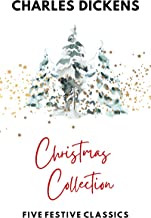My ancient copy of Christmas Stories by Charles Dickens is inscribed “To Susan with love from Aunty Jill xx 1956”. Jill was my mother’s much younger sister. In 1956, she’d have been 20. I was nine. I suppose I was perceived, with some accuracy, as a bookish child. Of course I read them then and have dipped many times since. Coming back to them now, I’m struck by a number of things – not least that my old Heirloom Library edition with illustrations by William Littlewood contains just three stories: A Christmas Carol, The Chimes and The Cricket on the Hearth. There are actually two more (The Battle of Life and The Haunted Man) which get included in modern collections, because after A Christmas Carol, published in 1843, when Dickens was only 32, he knew he was on to a (very) good thing. He called these five stories his “Carol series”
A Christmas Carol is so well known that everyone “knows” it. Ebeneezer Scrooge, courtesy of dozens of screen and stage adaptations, is one of a handful of literary characters (Mr Darcy and Charles Dodgson’s Alice are other examples) who has a vibrant public consciousness existence far from the pages which gave birth to him. This year, wearing my theatre reviewing hat, I have, several different dramatised versions of this seasonal classic lined up to see – as usual.

So it’s quite interesting to go back to where it all started and read what Dickens actually wrote. Ever theatrical, Dickens structured it like a three act play preceded by a prologue and completed with an epilogue which form a framing device. Thus we start with an exposition of Scrooge’s meanness and then his vision of Marley, work through the three spirits and then finally see the reformed Scrooge making amends and doing good. It’s neat and satisfying without ever feeling contrived. I’m also struck, long sentences notwithstanding, by the straightforwardness of Dickens’s language: “After tea, they had some music” or “He went to church, and walked about the streets, and watched the people hurrying to and fro, and patted children on the head, and questioned beggars, and looked down into the kitchens of houses, and up to the windows: and found that everything could yield him pleasure”. Yes, I can see how I could have read this stuff quite comfortably when I was only nine.
And, incidentally, I used to send my secondary school English students to Mr Dickens when I was trying to undo the damage done by blinkered primary school teachers who had taught them that a sentence must never start with a conjunction. Dickens, arguably the greatest writer in English after Shakespeare, does it on almost every page (“And it was clear he meant to do it” “But now a knocking at the door was heard …”. And if it was good enough for him ..? (Alert readers, moreover, will spot that I deliberately did it twice in this paragraph)
My favourite passage was always the description of the Cratchits’ Christmas pudding and it still is. At nine, I couldn’t have identified gentle irony as the reason it works so well. Today I can analyse and admire the warmth with which he conveys the tiny size of the pudding for such a big, impoverished family alongside their utter delight in it. It is, actually, very beautiful and an example of stunningly good writing.
The Chimes followed a year later in 1844 and he was clearly trying to follow the success of A Christmas Carol which it resembles in many ways as Toby/Trotty the poor porter trying to make things better for his daughter is eventually confronted by the ghostly church chimes. Tellingly it hasn’t grabbed the public imagination to anything like the same extent and hasn’t been adapted so often.
The Cricket on the Hearth (1845) is a domestic fairy tale about John and Dot Peerybingle (where on earth did Dickens find his wonderful names?) and their baby. The titular chirping insect acts as a sort of guardian angel to the family. It isn’t desperately “Christmassy” but it works. It has to be said, though, that of these three long short stories/novellas A Christmas Carol is by far the best.
Treat yourself to a reread on these dark winter nights and see if you agree.
Next week on Susan’s Bookshelves: As I Lay Dying by William Falkner